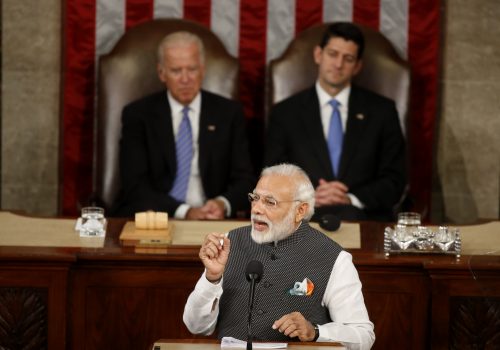Reimagining the US-India trade relationship
The United States and India have long striven to maintain and deepen bilateral ties, weathering Cold War tensions and antagonisms over India’s nuclear tests to reinvigorate linkages and strengthen cooperation. Today’s modern US-India relationship continues to develop under a broad-based and multisectoral framework nurtured by common strategic interests and an engaged Indian diaspora in the United States, yet advancements in trade relations have faltered in comparison: though US-India trade has grown steadily, from a mere $16 billion in 1999 to a more robust $146 billion in 2019, long-standing disagreements over critical issues and the lack of structural trade agreements between both countries mar attempts to achieve the full perceived potential of the relationship. Most recent, last year’s failure to conclude even a mini trade deal, in spite of much rhetoric emphasizing its importance, highlights the gulf between trade orientations and negotiating postures in New Delhi and Washington, and is a stark reminder of the challenges and limitations of the present relationship.
This report, each chapter curated by a leading expert and South Asia Center nonresident senior fellow, examines US and Indian trade relations, both bilateral and global, and offers forward-thinking policies to help governments in both countries achieve a deeper trade relationship. The various views and ideas expressed by both Indian and US trade-policy experts and industry leaders present a comprehensive analysis to resolve disagreements and establish a short-, medium-, and long-term framework for cooperation. The first and second sections analyze Indian and US trade negotiations and dialogues, respectively, from the recent past to identify strategies moving forward; the third section offers an overview of the last decade in US-India trade negotiations, illuminating concrete achievements and obstinate hurdles; and the final section identifies low-hanging fruit that negotiations often lose sight of and that offer immediate opportunity to secure wins that could reanimate trade negotiations now that there’s a new US administration in place. The two governments should:
- take an incremental approach focusing on low-hanging fruit and gradually build up to more significant areas of contention;
- address trade issues head on rather than defer them to prioritize strategic cooperation;
- recommit to a free trade agreement; and
- establish the institutional architecture to ensure successful negotiations.

The South Asia Center is the hub for the Atlantic Council’s analysis of the political, social, geographical, and cultural diversity of the region. At the intersection of South Asia and its geopolitics, SAC cultivates dialogue to shape policy and forge ties between the region and the global community.
